Page 5
~ The Study of Threes ~
http://threesology.org
| pg 1 | pg 2 | pg 3 | pg 4 | pg 5 |
3 phases of memory: encoding (deciding what information is important), storing, and recalling. (Anatomy of the Brain)
- 1 brain, 1 head, 1 mind
- 2 hemispheres (right/left), 2 divisions: (cerebrum/cerebellum), 2 types (male/female)... etc...
- 3 (triune) divisions (Reptilian- old Mammalian- Neo-mammalian), or (Hindbrain- Midbrain- Forebrain) or Limbic
- 3 brain stem divisions: midbrain- pons- medula oblongata
- 3 compositions of the brain: cerebrum, cerebellum, and brainstem.
- 3 cortexs: paleocortex, or paleopallium- archicortex (or archipallium)- neocortex (or neopallium) ( Wikipedia: Paleocortex)
- 4 cerebral hemisphere functions: the frontal, parietal, temporal, and occipital lobes; 4 quadrants: Logical/Creative... Practical/Relational, etc...
- 4 Major dopaminergic pathways: Mesocortical pathway- Mesolimbic pathway- Nigrostriatal pathway- Tuberoinfundibular pathway: (List of regions in the human brain)
- 5 major brain areas: Frontal lobe, Parietal Lobe, Parietal Lobe, Temporal Lobe, Cerebellum
6 deep structures:
- Hypothalamus: is located in the floor of the third ventricle and is the master control of the autonomic system. It plays a role in controlling behaviors such as hunger, thirst, sleep, and sexual response. It also regulates body temperature, blood pressure, emotions, and secretion of hormones.
- Pituitary gland: lies in a small pocket of bone at the skull base called the sella turcica. The pituitary gland is connected to the hypothalamus of the brain by the pituitary stalk. Known as the “master gland,” it controls other endocrine glands in the body. It secretes hormones that control sexual development, promote bone and muscle growth, and respond to stress.
- Pineal gland: is located behind the third ventricle. It helps regulate the body’s internal clock and circadian rhythms by secreting melatonin. It has some role in sexual development.
- Thalamus: serves as a relay station for almost all information that comes and goes to the cortex. It plays a role in pain sensation, attention, alertness and memory.
- Basal ganglia: includes the caudate, putamen and globus pallidus. These nuclei work with the cerebellum to coordinate fine motions, such as fingertip movements.
- Limbic system: is the center of our emotions, learning, and memory. Included in this system are the cingulate gyri, hypothalamus, amygdala (emotional reactions) and hippocampus (memory).
7 areas, sections, divisions, parts, etc... (Surprisingly, their is a stark absence of this number value being repeatedly used to describe the brain, despite the argument that the value "7" is preeminently important). However, I did find one reference:
- The frontal lobe: Personality, attention, and social interaction. Humans have the most developed frontal lobe of any animal in the world.
- The parietal lobe: Sensation, particularly the sense of touch. Also, muscle control.
- The temporal lobe: Hearing, certain types of memory, and language.
- The occipital lobe: Vision. That’s all. Vision. Sight is the only sense with its own dedicated lobe. There's more brain space devoted to processing sight than any other sense. This is why it's the most important sense in most people. In blind people, the hearing, touch, and smell centers of the brain invade the occipital lobe, which means more brain space for these senses. This is why the blind people have such sharp senses of hearing and touch compared to people who can see.
- The limbic system and hypothalamus: This is a collection of structures located deep inside your brain which control the actions you take in order to keep yourself alive. The hypothalamus is responsible for hunger, thirst, and temperature regulation. The limbic system is in charge of emotions like fear and desire. It’s also involved in memory and sense of smell.
- The cerebellum: Muscle control and muscle memory. When you go through a complex series of movements without thinking about it, like playing a musical instrument or doing a basketball jump shot, that’s your cerebellum taking over.
- The brain stem: This is absolutely, completely, 100% essential for your survival. That’s because the brain stem controls your heart and your lungs. It’s also involved in pain, regulating sleep-wake cycles, and transmitting information from the brain to the spinal cord and down to rest of the body. In the picture on the left, this is the bit which includes the pons and medulla oblongata.
Parts of the brain (Sunday, 1 April 2012)
- 8 or 8 functional brain areas:
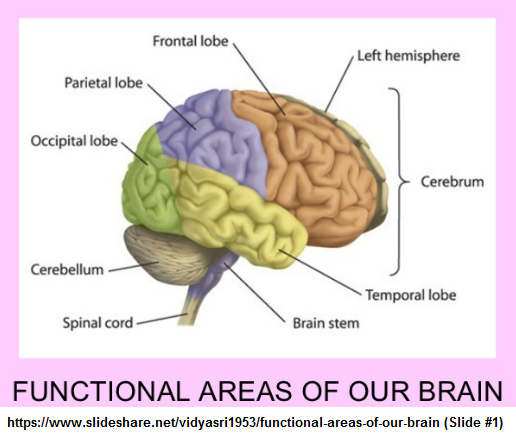
- 16 labeled locations of the brain:
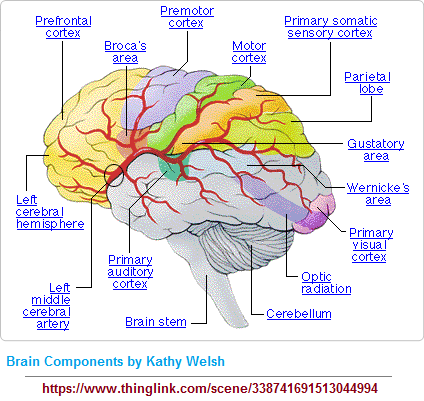
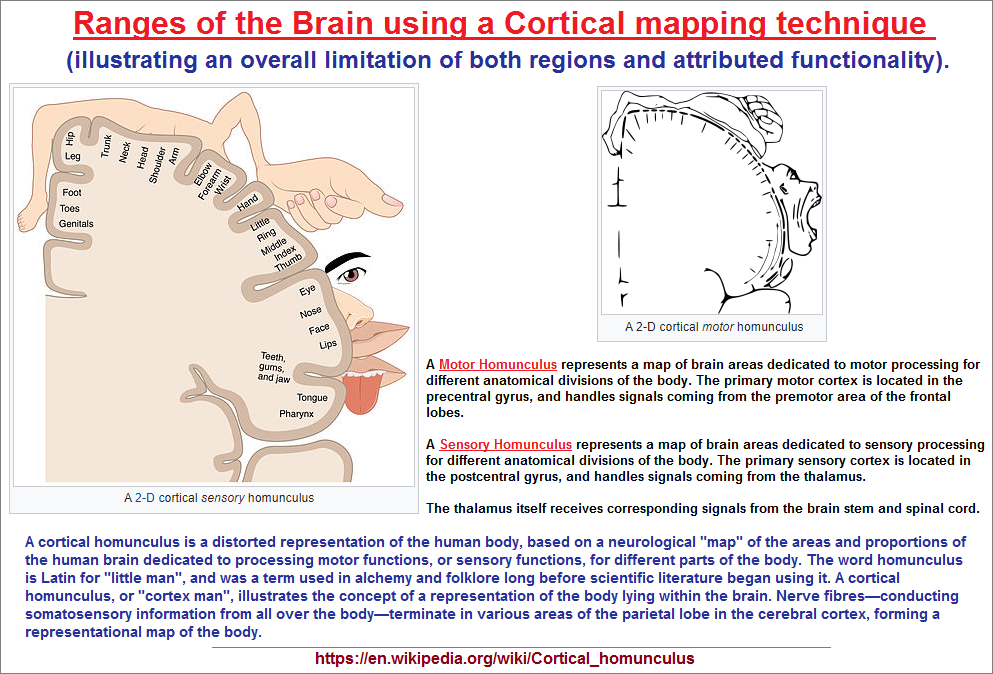
In looking at the brain and mind associated with mental activity or non-activity, we must include a reference for that which is described as psychological categories related to the various dimensions of personality, socialization, educatableness, self-sufficiency, etc...
Let us begin with three related categories sometimes lumped together:
The Clinical History of 'Moron,' 'Idiot,' and 'Imbecile'
- Idiots.— Those so defective that the mental development never exceeds that or a normal child of about two years.
- Imbeciles.— Those whose development is higher than that of an idiot, but whose intelligence does not exceed that of a normal child of about seven years.
- Morons.— Those whose mental development is above that of an imbecile, but does not exceed that of a normal child of about twelve years. (— Edmund Burke Huey, Backward and Feeble-Minded Children, 1912)
In the following reference from: Wikipedia: Classification of mental disorders, we have 10, then 5, then 17 categories of classification:
The International Classification of Diseases (ICD) is an international standard diagnostic classification for a wide variety of health conditions. The ICD-10 states that mental disorder is "not an exact term", although is generally used "...to imply the existence of a clinically recognizable set of symptoms or behaviors associated in most cases with distress and with interference with personal functions." Chapter V focuses on "mental and Behavioral disorders" and consists of 10 main groups. Within each group there are more specific sub-categories. The WHO is revising their classifications in this section as part of the development of the ICD-11 (revision due by 2018) and an "International Advisory Group" has been established to guide this.
- F0: Organic, including symptomatic, mental disorders
- F1: Mental and Behavioral disorders due to use of psychoactive substances
- F2: Schizophrenia, schizotypal and delusional disorders
- F3: Mood [affective] disorders
- F4: Neurotic, stress-related and somatoform disorders
- F5: Behavioral syndromes associated with physiological disturbances and physical factors
- F6: Disorders of personality and behavior in adult persons
- F7: Mental retardation
- F8: Disorders of psychological development
- F9: Behavioral and emotional disorders with onset usually occurring in childhood and adolescence
- In addition, a group of "unspecified mental disorders".
The DSM-IV was originally published in 1994 and listed more than 250 mental disorders. It was produced by the American Psychiatric Association and it characterizes mental disorder as "a clinically significant behavioral or psychological syndrome or pattern that occurs in an individual,...is associated with present distress...or disability...or with a significant increased risk of suffering" but that " ...no definition adequately specifies precise boundaries for the concept of 'mental disorder' ...different situations call for different definitions" (APA, 1994 and 2000). The DSM also states that "there is no assumption that each category of mental disorder is a completely discrete entity with absolute boundaries dividing it from other mental disorders or from no mental disorders."
The DSM-IV-TR (Text Revision, 2000) consisted of five axes (domains) on which disorder could be assessed. The five axes were:
- Axis I: Clinical Disorders (all mental disorders except Personality Disorders and Mental Retardation)
- Axis II: Personality Disorders and Mental Retardation
- Axis III: General Medical Conditions (must be connected to a Mental Disorder)
- Axis IV: Psychosocial and Environmental Problems (for example limited social support network)
- Axis V: Global Assessment of Functioning (Psychological, social and job-related functions are evaluated on a continuum between mental health and extreme mental disorder)
The axis classification system was removed in the DSM-5 and is now mostly of historical significance. The main categories of disorder in the DSM are:
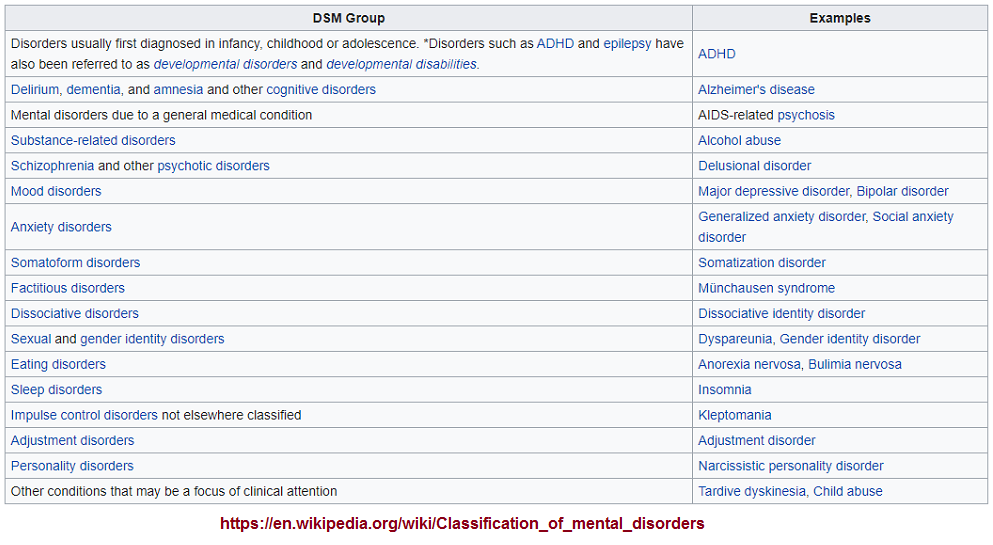
DSM-5 defines intellectual disabilities as neuro-developmental disorders that begin in childhood and are characterized by intellectual difficulties as well as difficulties in conceptual, social, and practical areas of living. The DSM-5 diagnosis of ID requires the satisfaction of three criteria: (Clinical Characteristics of Intellectual Disabilities)
- Deficits in intellectual functioning—“reasoning, problem solving, planning, abstract thinking, judgment, academic learning, and learning from experience” —confirmed by clinical evaluation and individualized standard IQ testing (APA, 2013, p. 33.)
- Deficits in adaptive functioning that significantly hamper conforming to developmental and socio-cultural standards for the individual's independence and ability to meet their social responsibility.
- the onset of these deficits during childhood.
Let us look at Clinical Characteristics of Intellectual Disabilities (Classifications of Intellectual Disability Severity... Mental Disorders and Disabilities Among Low-Income Children.):
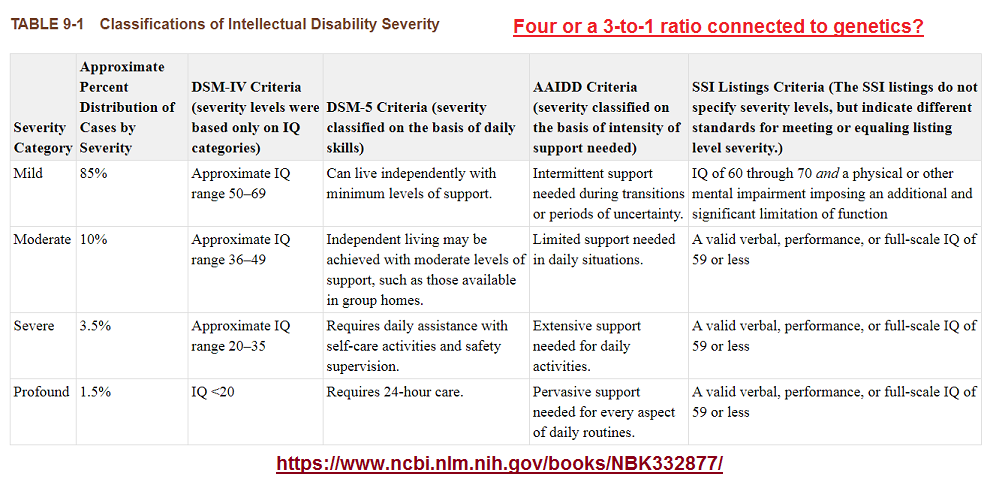
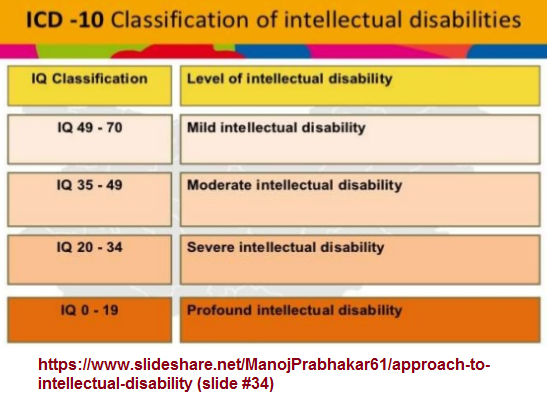
Associative ideas:
Mental deficiency: idiot, imbecile, and moron IQ Basics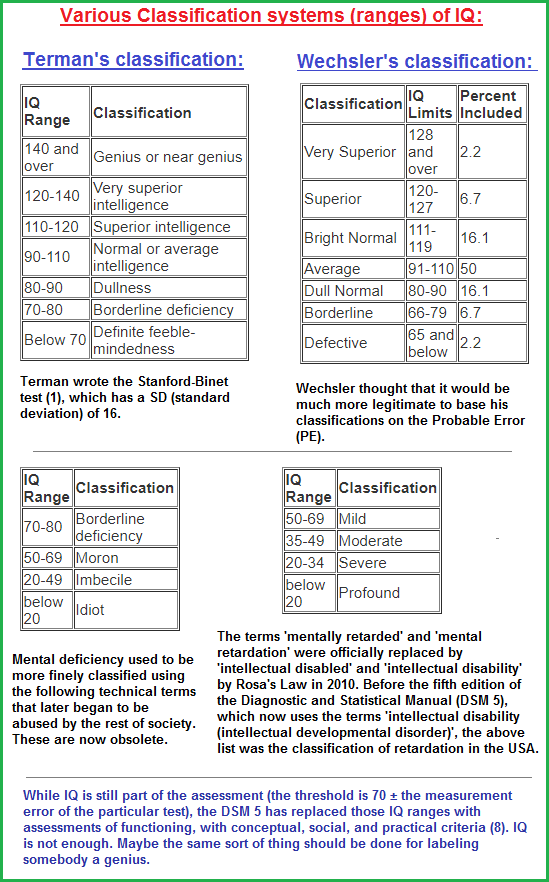
8 core cognitive categories idea: Cognitive Skills: Why The 8 Core Cognitive Capacities
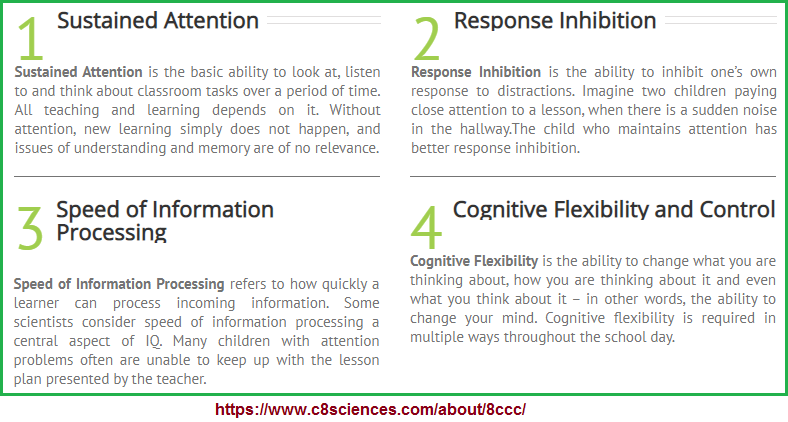
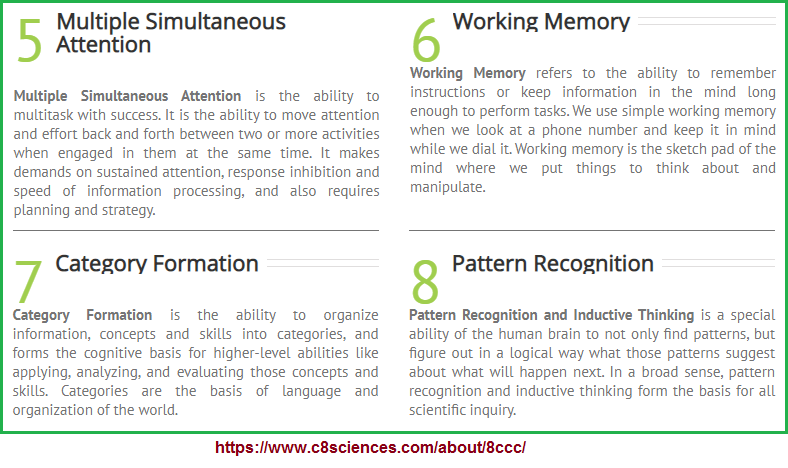
With respect to developing an enlarged appreciation of ranges, we need also to include the category of aging (which should also include looking at blood chemistry since an elderly person can have the chemistry of a very young person as was described to me about mine by a V.A. (Veterans Administration) Dr.): (What is your age?)
When it comes to our health, time is not always on our side. With passage of time, our bodies deteriorate and we start to lose function. We call this aging and determine our age by the number of times earth has revolved around the sun since our birth. But is this really how we should calculate our age? We all have varying degrees of health preservation or deterioration. With modern science and technology, we have sophisticated and precise ways to determine how much function and structure we have lost over the course of time. Why not try to preserve it for as long as possible and improve our health span.
Below are some markers of determining several aspects of aging.
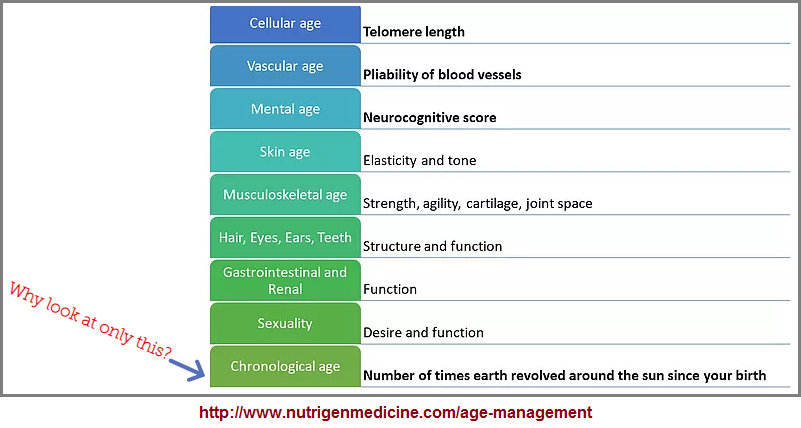
Nonetheless, how do we measure the range of human thought in terms of a quantification to be compared with other enumerated examples, even if there is no one-to-one exact quality? Whereas we can use some arbitrary number such as 9 for the upper range and 1 for the lower range, we are again met with a limited range. Likewise for any enumerated supposition, though we might say "infinity" or use the word "god" to imply unlimitedness, that we are nonetheless describing as an upper limitation. If humans can quantify it or even suppose a non-quantification for it, this too is the quantification of a presumed non-quantification. Neither our language nor enumeration permits us to exceed the "large" category, so-to-speak, without enlisting some notion of the large such as in using the X-large, XX-large, XXX-large labeling terms. Likewise, we also resort to a compartmentalization of numbers when compiling three numbers in sequences such as ones-tens-hundreds as a three-patterned ensemble before beginning another set of three, again and again as if repeating ourselves like a babbling infant.
While it is understood that a loss of hearing can cause multiple developmental and social problems, what is not being discussed is how the effects of the recurring "threes" (and non-threes) pattern(s) affects speech development, cognition and socialization... perhaps simply because not only does a "threes" oriented realization not exist as a universal research identity, but we simply do not customarily subject inquiries into the philosophical realm of such suppositioning.
- Hearing Loss: How It Affects Communication
- Effects of Hearing Loss on Development
- The Connection Between Hearing and Speech Development
- 8 Things Untreated Hearing Loss Can Impact by Sarah Bricker, Feb 16, 2016
- Effect of Early Intervention on Language Development in Hearing-Impaired Children by Elahe Shojaei, Zahra Jafari, and Maryam Gholami
- Effects of Hearing Loss on Development
- Articles by American Speech-Language-Hearing Association
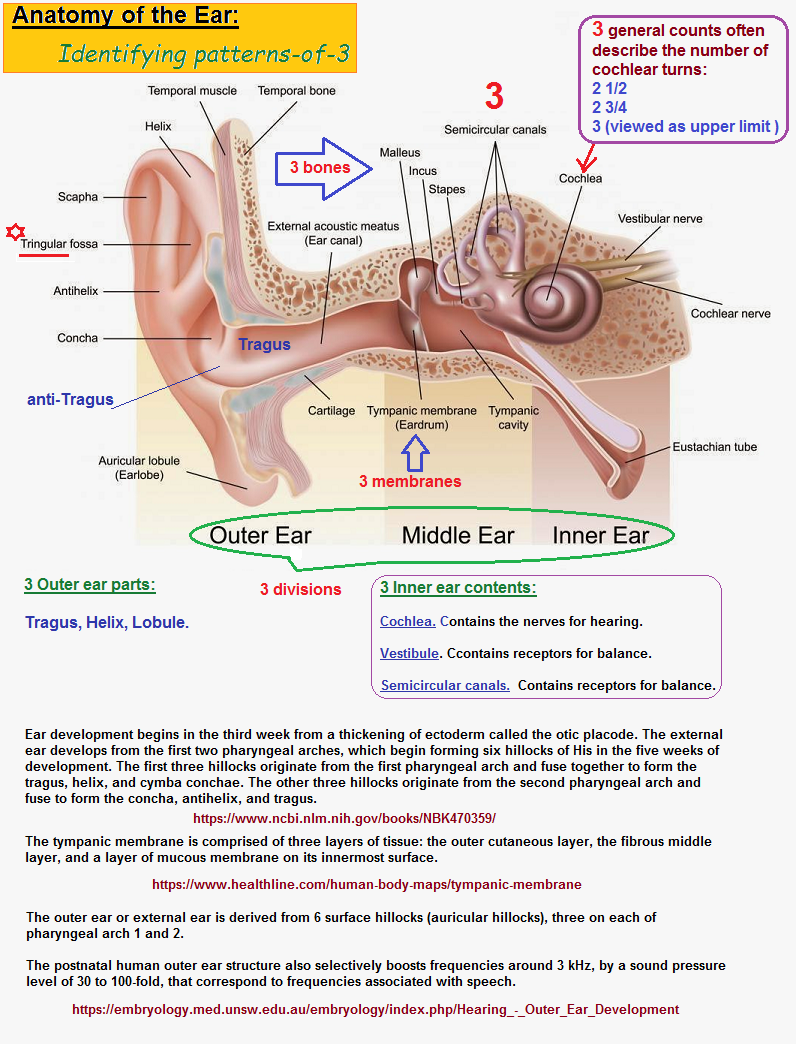
|
| |
| 3 overall divisions: | Outer ear~ Inner ear~ Middle ear |
| 3 middle ear divisions: | Tympanum~ Epitympanum~ Mastoid antrum |
| 3 eardrum membranes: | Cutaneum~ Collagen fibers~ Mucosm |
| 3 semi-circular canals: | Used for balance (equilibrium) |
| 3 bones: | (ossicular chain) Incus~ Stapes~ Malleus |
| 3 main malleus ligaments: | Anterior~ Lateral~ Superior |
| 3 incus anchorage points: | Malleus~ Stapes~ Bony fossa wall |
| 3 cochlea sections: | (Scala) Vestibuli~ Tympani~ Cochlear duct |
| 3 extrinsic muscles (Auricularis): | Anterior~ Superior~ Posterior |
| 3 sound conduction paths: | Electrical~ Mechanical~ Fluid or: Bone (solid)~ Air (gas)~ Fluid (liquid) |
| 3 nerve stimulation paths: | Mechanical~ Chemical~ Electrical |
| 3 outer hair cell rows (also 1 inner hair cell row, thus; a 3 to 1 ratio) |
typical in mammals but some sources give 3, 4, or 5 |
| Neurotrophin-3 (NT-3) is synthesized by inner and outer hair cells of the developing organ of Corti. | Brain-derived neurotrophic factor (BDNF) is also synthesized. (Prestin is the motor protein of the outer hair cells.) |
| 3 sound qualities: | Pitch~ Volume (intensity)~ Tone |
| 3 sound wave propagation processes: | Diffraction~ Transmission~ Reflection |
| 3 main forms of ossicular chain fixation: | Fluid~ Mechanical~ Otosclerosis |
| 3 classes of ossicular lever action: | Force arm~ Resistance arm~ Fulcrum |
| 3 acoustic distortion forms: | Frequency~ Phase~ Amplitude |
| 3 basic properties of vibrating bodies: | Inertia~ Elasticity~ Dissipation |
| 3 principal types of deafness: | Conduction~ Nerve~Stimulation |
| 3 types of hearing loss: | Conductive~ Sensorineural~ Mixed |
| 3 (inner ear) organs of balance: | Semicircular canals~ Utricle~ Saccule (collectively called the vestibular organ, which can be referred to as a {3-in-1} ratio.) |
If we replace the three bones (Incus-Malleus-Stapes), the three semi-circular canals used for equilibrium, and the three eardrum membranes with another quantity, speech... and thus thinking may well be altered accordingly. If the human ear exhibited a different, other-than-three pattern, human thinking might well be considerably different, just as it would if we lived on a different planet with a different formula of genetic code. In other words, surely there would be a difference in language and thinking if there was an exhibition of another enumerated pattern. And this is the salient point to make. That which we see, say and surmise is a particularized pattern because of the structure for which we can see, say and surmise, and thus permit us an insight into seeing, saying, and surmising otherwise. Recognizing the presence of a repetition (let us call it a positive repetition), as well as the absence of a repetition (let us call it a negative repetition); and referencing them both as a type of addiction (though someone might suggest the labels "habit" or "routine" or "practice", etc.), is the fist step in moving beyond it... whatever "beyond" the conventions of human sight, speech, and summation may mean other than the alternatives already created due to the present structures of our aural, oral and neural network of interrelationships where such pattern recognition as herein described is not the customary predisposition of research analysis, much less being used to develop theories, tests, experiments or other constructions presently left allocated to a usage by literary genres such as science fiction, fantasy, and hypothesized renderings on the outskirts of exploration by artists and mathematicians, though such sojourns of imagination being applied to tentative constructions of practicality are sometimes considered by different people from different walks of life who may view such excursions of mental exercise in negative or "ajared" labeling such as crazy, non-sensical, unrealistic, bizarre, abstract, metaphysical, etc...
However, it is of interest to note that while I pursue the accumulation of information from a "threesological" perspective that is not wholly "three" obsessed as some might want to infer, the correlations I make might well take on a different following if a different number pattern was being found to exist in the material where there is a recurrence of a "3" ensemble. For example, those interested in the number 7 would know doubt hail it as a great significance if (instead of "three" or "3rd"), we found:
- The Earth was in the 7th position of the solar system.
- DNA had a seven coding system.
- That people held a pen or pencil with 7 fingers.
- That the Rosetta stone, Behistun rock formation, and Galle inscription each had seven languages.
- There were seven fundamental particles in atomic particle construction.
- The inner ear had seven bones, 7 circular canals, 7 eardrum membranes, etc...
- Pregnancy was divided into 7 semesters.
- There were 7 college degrees.
- There were 7 divisions to time.
- Etc...
Likewise if such things had a recurring numerical value of 13, or 2, or 8, or 11, or some other number but three. In other words, just as much as we appear to be surrounded by a recurrent usage of the "3" evaluation descriptive, there is what appears to be either a conscious or unconscious disinclination to make a conscious account of such a recurrence of not only the "3", but its absence and its absence filled with some other value which is also dismissed from an active social account, except to disparage any and all accounts by labeling them an exercise in "numerology"; which is a term that is arbitrarily defined in non-explicit ways other than to be used as a label of a discredited mental exercise, whether philosophically based or as an engaged in pastime as one might do in a similar fashion as crossword puzzles, etc..., which include the three-patterned exercises of tic-tac-toe, diagonal-vertical-horizontal movement of game pieces such as checker and chess, use of three face cards in a deck of cards, the rock-paper-scissors betting theme, the three-patterned "knit one, pearl two" of knitting, holding a pen or pencil with three fingers while doodling, etc...
While we humans are sometimes quick to pronounce the presence of a pattern (to be used to suggest a confirmation or evidence when citing that to be defined as good or bad), we are not so quick to actively make a pronouncement of an absence and that the absence has some other item in its place that may well be an indicator of another recurring pattern in the same or some other context, with all contexts needing to be judged as representing a facet of human applied cognition in the perception and interpretation thereof.
It is of global cultural significance to make note of the fact that, apparently, all current intellectual resources do not give a singular account of the three major archaeologically-uncovered three-language descriptions known as the Rosetta stone, Behistun Rock formation and Galle Inscription. If such inscriptions involved 7 languages or 13 languages or some other number linked with a wide-spread superstitious orientation, they most likely would be referred to in the same context such as encyclopedias and the separate references one presently encounters on the internet... quite possibly because the authors writing about such accounts are not familiar with the other two. And as of this 12/2/2019 date, who knows, other as yet-to-be uncovered examples may well exist burying away in some crevice or pile of sand.
Likewise, the presence of the "three" in the human ear, and the very important role in which hearing plays in speech and speech in human thinking (cognition), is itself a monument, a type of inscription that can be interpreted as a type of expressed 3-language ensemble, just as we can interpret the three large atomic particles (protons- neutrons- electrons) as different languages related to one another. The problem is we do not have the appropriate type of linguist analyzing all the different types of 3-ensemble languages found in different subject areas. The human mind is recurringly using a three-patterned formula in multiple subject areas as a means of communicating that which falls on deaf ears. However, by labeling such three-patterned ensembles as a type of language, or if you prefer, a code or a formula, someone may well begin to identify similarities that are not otherwise seen in order to uncover the underlying theme or "message".
If the "three" (or any enumerated pattern) is actually that important, then one might suggest it to be used for all things... except that it is not, which means it is either inappropriate or humans have not yet learned how to interpret given information in such a way so as to convey their perceptions in a three-part language ensemble.
When we discover that most, if not all languages in the world contain a three-patterned formula of Subject- Object- Verb, (though not necessarily in this order), instead of correlating this finding with the pattern-of-threes found in the human ear, researchers instead focus on the variations that such a pattern may or may not have within the subject field. The research is not permitted to leave the domain in which it is found and applied to a larger context, even though the processes of hearing are directly related to language, like water from a snowed over mountain providing the source of water which runs to the fields below. It is like dealing with primitive peoples who think that the water they are hording and paying tribute to as a gift from god, is some all-important theme to create various ceremonialisms around and provide social status to those who adopt a standard of knowledge and thinking about the subject but not any contributory source. If something presumed to be as new is uncovered in the many derivatives of internalized associations are identified, a person may well receive an acknowledged academic credit and value, but not those whose explorations beyond the subject if they bring back news of a possible source. Because such explorations by independent researchers is not bought and paid for expeditions by an institutionalized body, their individual efforts are dismissed and diminished, until such time that their findings can be used to provide someone in their accepted domain of research with credit.
Origination date: Monday, December 2nd, 2019... 5:47 AM
Initial Posting: Thursday, December 26th, 2019... 9:58 AM
Updated Posting: Tuesday, February 7th, 2023... 10:45 AM
Herb O. Buckland
herbobuckland@hotmail.com